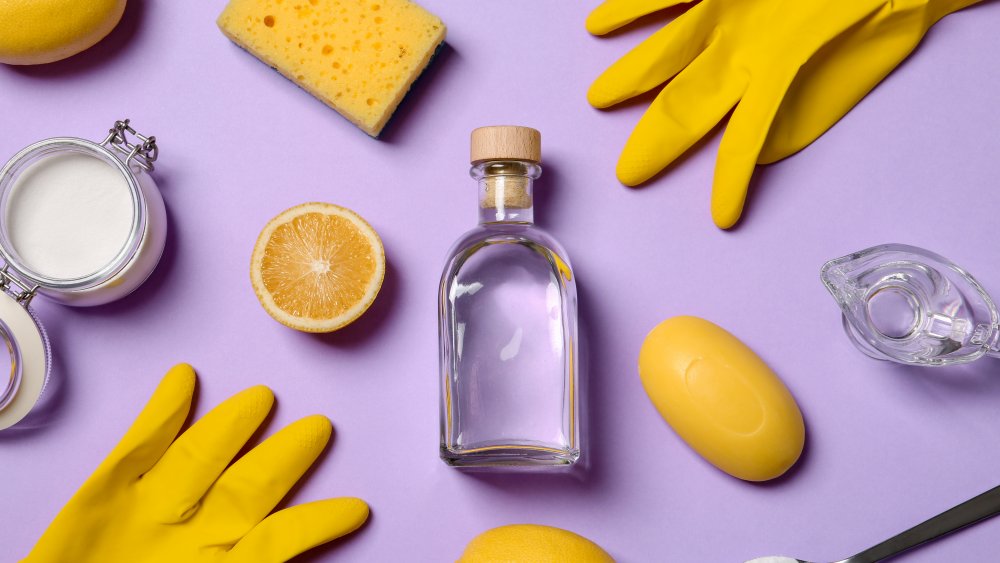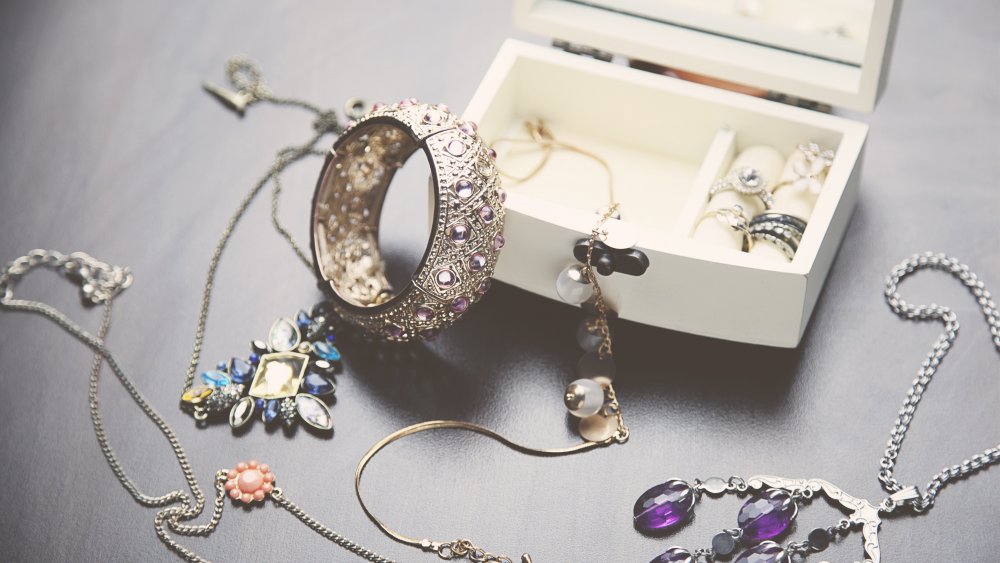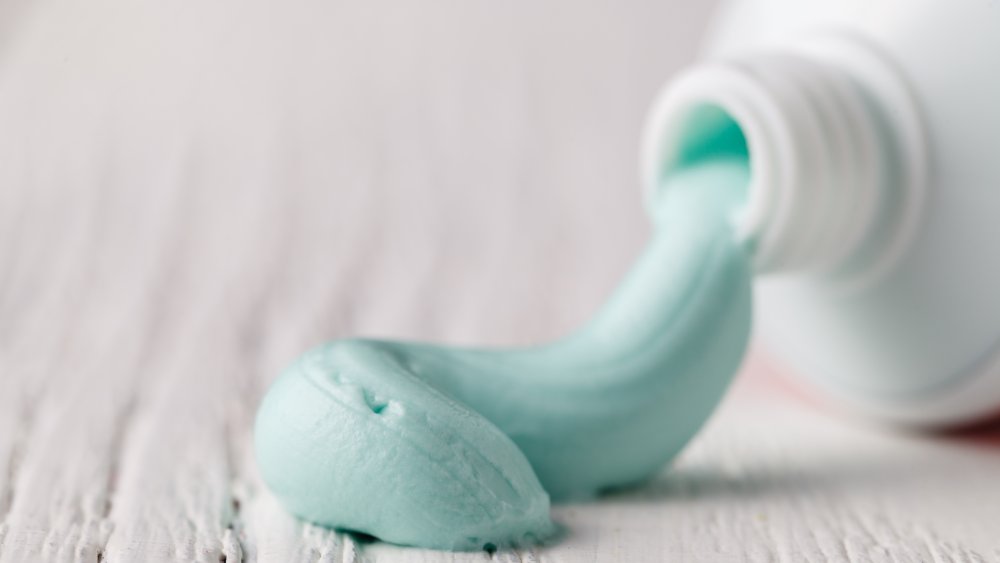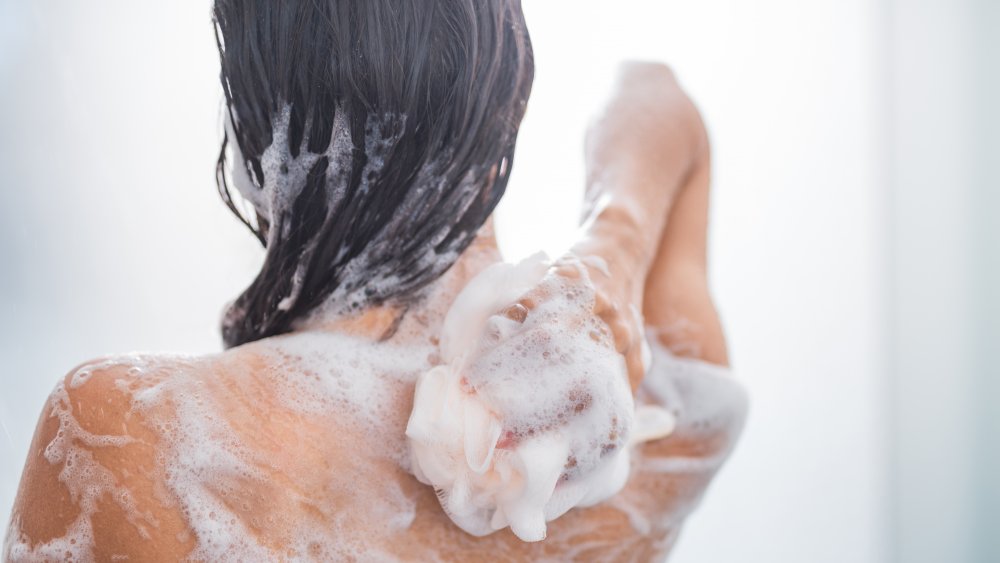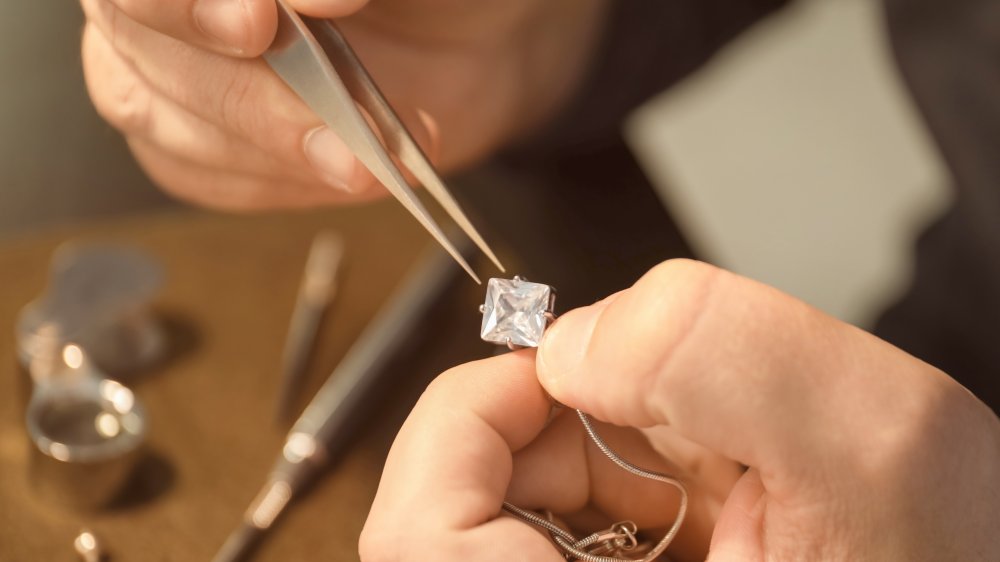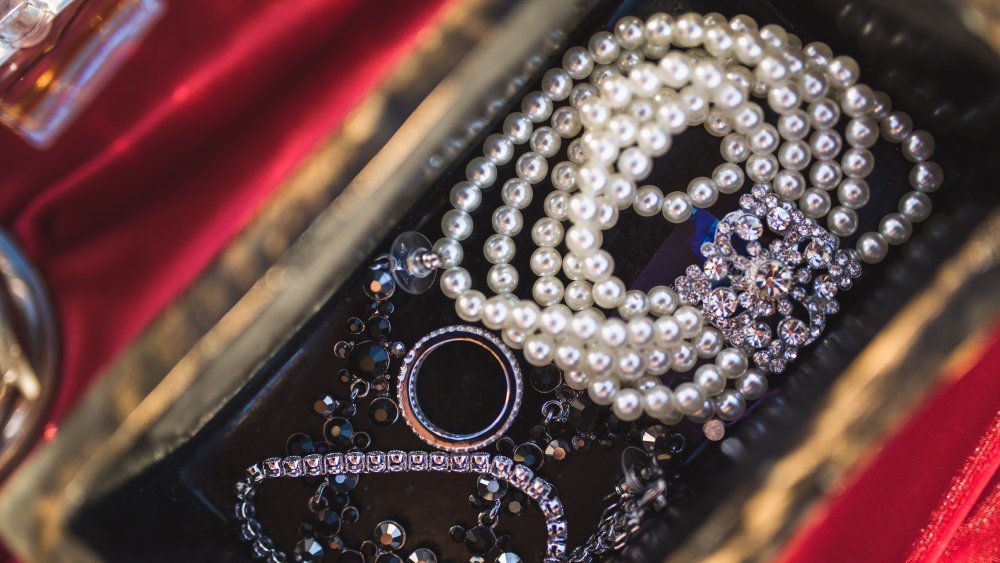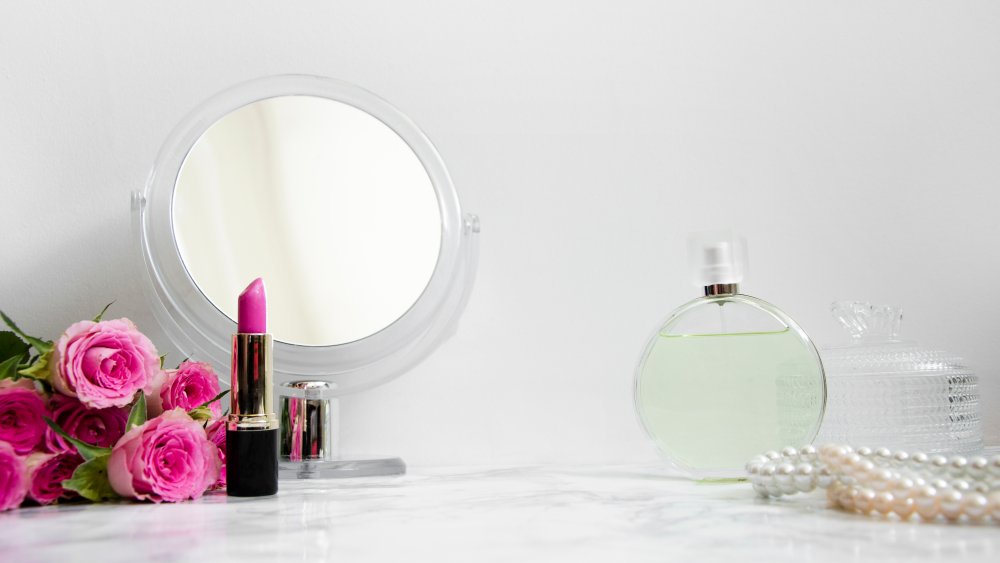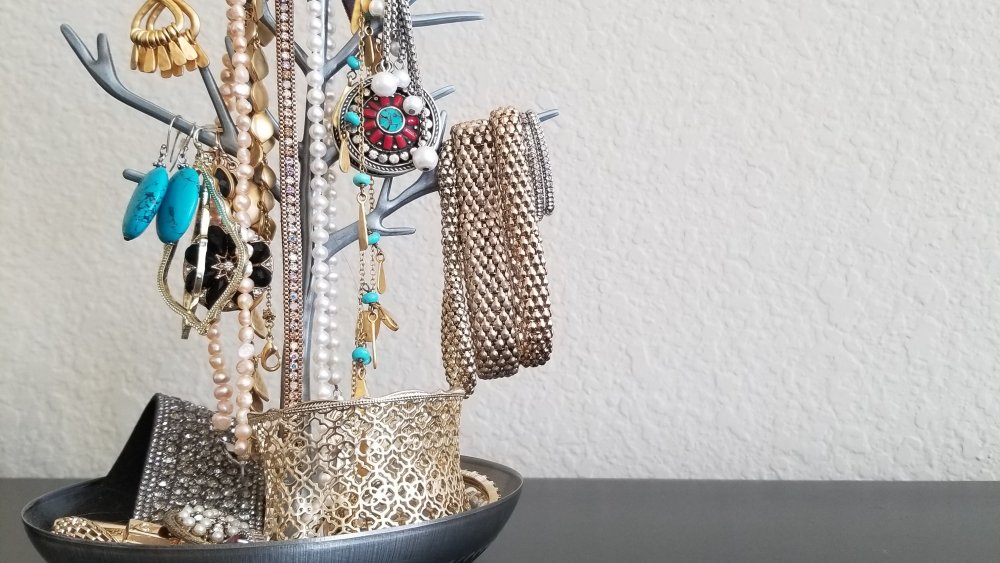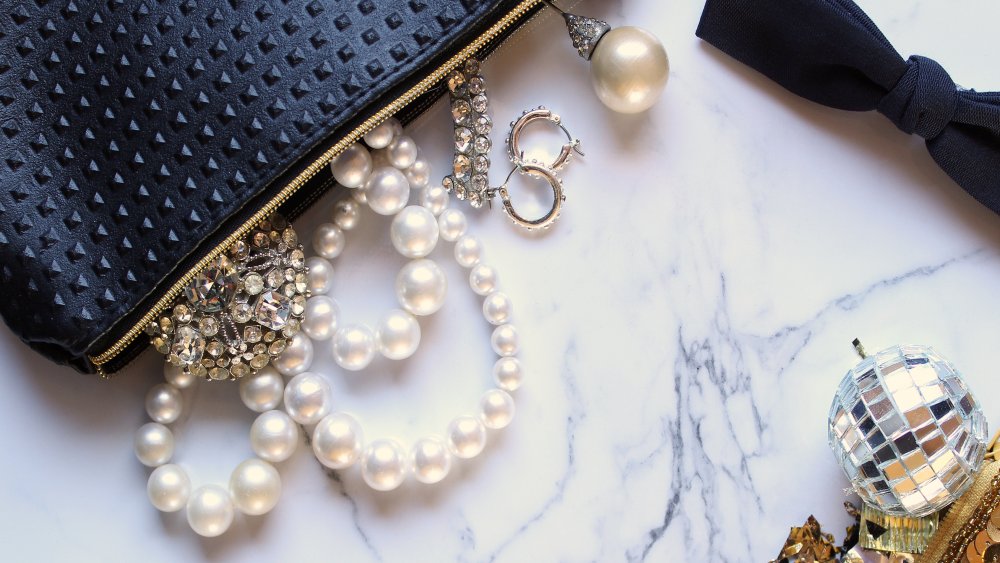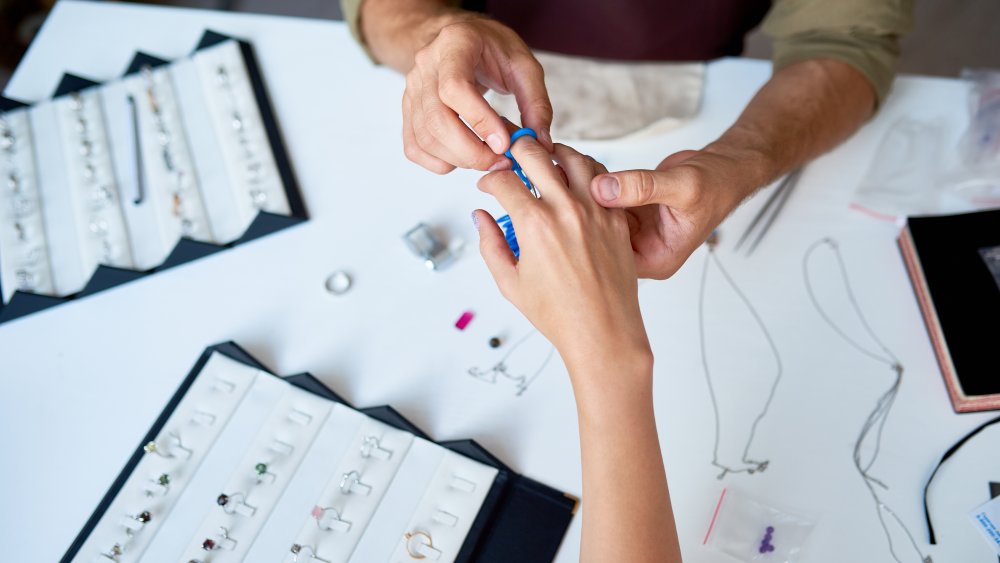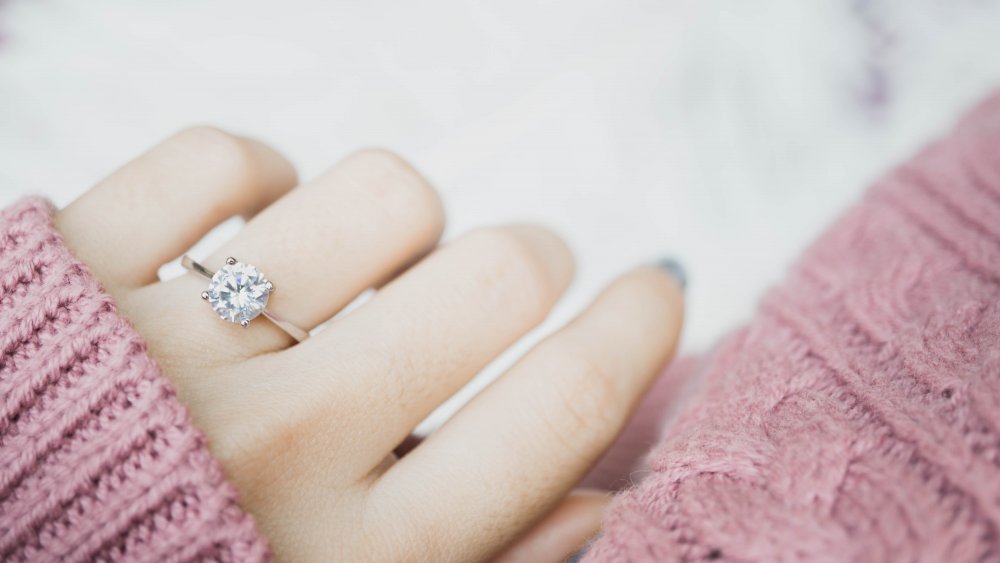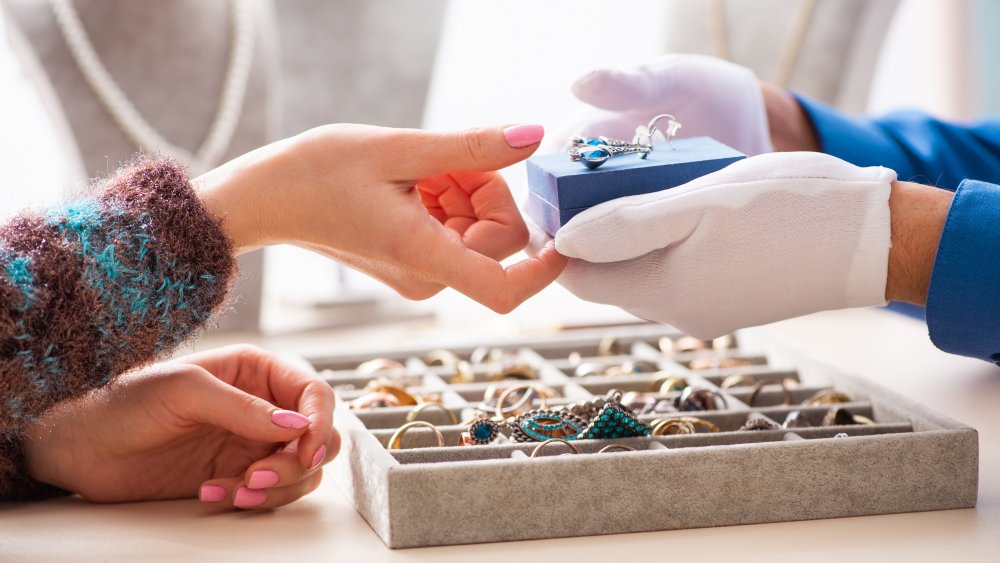You've Been Treating Your Jewelry Wrong This Whole Time
Jewelry can make or break a look. Glamorous pieces will add some not-so-subtle sparkle and pizzazz while more classic and traditional accessories are often the finishing touches to a polished ensemble. You may like your lockets and treasure your trinkets, but you have to do more than appreciate your jewelry's beauty to properly preserve a curated collection. What's more, you might even be making a few damaging mistakes when it comes to handling, cleaning, and storing your beloved bling.
Unfortunately, many commonly accepted hacks will do more harm than good. So, how can you make sure your diamond studs, pearl strands, and refined rings stand the test of time and weather the woes of wear? Allow us to clarify the do's and don'ts of caring for your prized pieces because, as it turns out, too many of us have been treating our jewelry wrong this whole time and never even stopped to think about it. Here's what we learned.
You've been treating your jewelry all wrong by using harsh household cleaners
It may seem like an easy solution, but, no, you should not be digging under your sink for household cleaners to use on your jewelry collection. Save the heavy-duty abrasives and bleaches for countertops and toilets. Your jewelry is far more delicate than your bathroom tile. Plus, some types of jewelry are extremely sensitive and could be seriously harmed by chemical ingredients. As Goodman's Jewelers explained, bleach causes a "chemical reaction that disintegrates the alloys in [gold] jewelry over time."
When in doubt, there is one easy thing you can do each and every day that is safe for most of your jewelry collection: Simply rub the pieces you have worn with a soft cloth to wipe away any excess oils and moisture, as suggested by Harper's Bazaar. Consider adding this task to your daily routine as it is a measure that's universally safe. However, take note that for most dull or faded pieces, a little bit of "dish soap with warm water" should do the trick, per the publication.
It's a mistake to use the same cleaning technique on all your jewelry
While there are many ways to deep-clean specific stones and metals, there is unfortunately not a one-size-fits-all method for thoroughly cleansing these different materials.
Silver polish, for example, is only suitable for — you guessed it — silver pieces. Gold jewelry, however, should be soaked in a warm water and dish detergent solution for five minutes, as suggested by Good Housekeeping. Vodka — or gin, as Queen Elizabeth personally prefers — will make diamonds sparkle. And if it's safe enough for the crown jewels, well, we think it'll be just fine for us.
When it comes to your gemstones, soak them in seltzer overnight, HuffPost advised, but don't do that to your pearls. These natural gems are extremely fragile and can easily lose their luster so it's important to never soak them. Instead, use a makeup brush dipped in warm water and gentle shampoo, as recommended by Harper's Bazaar. And, as for your favorite costume jewelry? Real Simple suggests trying a little lemon juice or white vinegar on oxidized pieces — as this will not only "get your costume jewelry clean, but give it a high shine too."
Toothpaste is the wrong choice for treating your jewelry
In case there was any confusion, toothpaste is meant for your pearly whites — not your face and definitely not your pearl necklaces or any fine jewelry for that matter. While the minty fresh bathroom-cabinet staple has long been touted as an acceptable cleaning agent for rings and other shiny things, many expert jewelers advise people to avoid this widely accepted do-it-yourself method completely.
Mark Mann, director of Global Jewelry Manufacturing Arts at the Gemological Institute of America (GIA) told Brides that one should "never use any kind of abrasive products," including "toothpaste, baking soda, or any powdered cleaners, which can easily scratch metals, particularly gold."
What's more, Day's Jewelers reiterates that since opals and pearls are extremely delicate, toothpaste can completely degrade their distinct hue and shine. Per the jewelry chain, the only time it is acceptable to use toothpaste for jewelry cleaning purposes is when scrubbing a loose diamond.
You're treating your jewelry wrong if you never take them off
Some of us wear certain pieces — a wedding ring, pair of diamond studs, meaningful necklace, et cetera — around the clock. But you may want to rethink your habits, particularly if you shower with your accessories on. As noted by jewelry designer Simone Walsh, there is a real risk of losing a precious piece down the drain. Moreover, accessories are also "likely to get gummed up by the residue from shampoos, conditioners, and soaps over time."
The high-end jeweler further advised taking off pieces before also going for a dip in a chlorinated pool, as the chemical can cause discoloration, and before swimming in the ocean, since salt water can dull diamonds and wear down certain metals.
In short: Water is mostly a no-no. You should also rethink wearing your favorite jewelry during certain activities. In an article for LoveToKnow, jewelry designer Kate Miller-Wilson advised taking off jewelry when cleaning around the house, gardening, and playing contact sports.
You're treating your jewelry wrong if you don't opt for professional cleanings
Your jeweler does so much more than sell necklaces and bracelets. The experts in jewelry stores are readily available to help you care for the jewelry you've already purchased. Consider these visits your precious jewelry's semi-annual wellness checkups.
When speaking with Today, jewelry experts advised people to take in their most prized possessions to a jeweler every six months. "Not only does this keep jewelry looking its best, it is also a good opportunity to check for loose stones and any wear or damage that should be addressed," Elizabeth Doyle, co-founder of jewelry brand Doyle & Doyle told the publication.
Pearl necklaces and bracelets should be restrung every five years or so to prevent the thread from wearing out and breaking, Rasmussen Diamonds explained on its site. And don't forget about your watches. Bob Moeller, owner of R.F. Moeller Jewelers in Minneapolis, Minnesota, told Good Housekeeping that he recommends having timepieces professionally serviced "every five to seven years."
Leaving your jewelry in the sun is all kinds of wrong
We wear sunscreen on our skin as the sun's UV rays are penetrating and damaging. Well, it turns out the sun's harsh light can also affect a gemstone's hue and strength. "Over time, and in excess," the Gemological Institute of America (GIA) explained, certain precious stones like "amethyst, kunzite, topaz and shell cameos" can fade from sun exposure. Pearls and ivory can actually bleach as a result of sunlight and darker stones, like amber, can become even darker in color.
But the sun's bright light is not the only potentially harmful issue. Extreme heat and dramatic fluctuations in temperature can actually cause breaks in certain stones. This is because the heat robs gemstones of their natural moisture. As noted by the GIA, "Pearls, for instance, can dry out, crack and discolor." So be sure to store your favorite jewelry in a cool space without direct exposure to sunlight.
You're treating your jewelry wrong if you don't follow this order
When you get ready to go to work in the morning or hit the town at night, make sure your jewelry is the last thing you put on before walking out the door. That means you should have your outfit on, your makeup done, and your hair styled before you clasp any necklaces, don any earrings, or put on any rings. Ingredients in skincare lotions, cosmetics, and hair products can be damaging to your shiny or sparkly accessories, noted jeweler Melissa Scoppa. Pearls are especially vulnerable as they are, according to Racked, "highly absorbent" so take extra care with your delicate strands.
Conversely, remove baubles and accessories before taking your clothes off at the end of the day. "Pulling a sweater off first can yank a chain in half or send an earring flying," jewelry designer Jill Maurer told Insider.
You're treating your necklaces wrong if you don't put them away after wearing
If you have ever sat for what felt like hours diligently untangling a ball of thin chain necklaces, unsure whether you're making it better or worse, then this one is for you. Instead of throwing your necklaces down on your nightstand after wearing, simply clasp and hang them in a jewelry box or stand, thus avoiding the entire knotty situation, per Good Housekeeping. But take note that you should never hang your pearls. They should always be gently placed flat to avoid stretching the string, as noted by Insider.
This may be easy enough to do at home, but what if you're traveling? Taking multiple small necklaces and bracelets and throwing them together will equal a mess, but you can avoid creating a big clump of gold and silver with a few simple packing hacks. Travel & Leisure suggests putting individual pieces of jewelry in the respective compartments of a pill case, using plastic wrap to separate each piece, or threading necklaces through drinking straws to avoid tangles.
You're treating your jewelry wrong by storing gold and silver together
There is a reason why jewelry boxes exist. They not only provide a means of organization, they also protect your precious heirlooms from daily damage and regular aging. Gold and silver pieces, in particular, should be separated from each other via lined compartments or even placed in separate cotton bags. This will also help minimize moisture exposure, but you can put a piece of chalk or charcoal inside storage areas to further absorb and protect. The experts at Mappin & Webb told The Telegraph that you can also try wrapping jewelry "in acid-free tissue or cotton to keep them away from dust and moisture."
At the end of a long day, it can be tempting to remove your jewelry and put it on the nearest piece of furniture. But it is important to realize that certain chemically-treated surfaces could also potentially harm your jewels. According to Harper's Bazaar, you should keep your jewelry away from wood as it can "stain or speed up the tarnishing process." Investing in a jewelry storage system will help you preserve the life of your pieces.
Yes, it's wrong to sleep in your jewelry
There are those busy evenings when you all you can do to wash your face and brush your teeth before flopping into bed. As part of your bare-minimum routine, you'll want to make sure you also remove your jewelry before your head hits the pillow.
Wearing jewelry while you sleep can harm your pieces and your body, jewelry designer Jill Maurer explained in an interview with Insider. She told the outlet, "Not only can you break a chain or bend a prong causing you to lose a stone, but earrings have been known to end up in a person's ear." This is why she stressed that "it's generally safer for you and your jewelry if you spend the night apart."
Marina Peredo, certified dermatologist and dermatology professor at Mount Sinai Hospital, told Self that prolonged overnight exposure could cause irritation, rash, and dryness in people with sensitivities to metals or certain materials. Additionally, she said that "wearing your jewelry while sleeping is the number one cause of losing gemstones and wearing out prongs."
You're treating your jewelry all wrong if you wear the same pieces every day
Have you been essentially living in the same signature necklace, bracelet, and studs day after day? It's time to embrace change and switch things up. Not only is the humdrum sameness of your style becoming a sartorial bore, the repetition and lack of rotation could also be damaging your favorite pieces.
Jewelry designer Simone Walsh reminded readers on her site that "everyday jewelry will get grimy in places you can't see or in ways that you don't necessarily notice because the changes take place slowly." She elaborates that this is especially true for earrings — and that the backings can be the most offensive, accruing ickiness that could possibly even cause infection.
Although you may not be willing to part with your everyday sentimental jewelry, like an engagement ring or wedding band, just make sure you give your body — and your jewelry — a regular, short break by removing and wiping down the item once daily.
If you haven't had your rings properly sized, you're treating them wrong
If a ring you own is too large for your finger, you should try to get it professionally resized whenever possible. Wear a too-loose ring and you run the risk of it slipping off your finger. Plus, when there's too much space, you can snag it and potentially cause damage. According to Brides, a ring "should fit snugly but comfortably." It should also "slide on easily, but you should have to pull a little to get it off."
The digital bridal magazine noted that only silver, gold, and platinum rings are suitable for resizing, but glitzy diamond eternity bands present a tricky situation as there is no "bare metal to work with." Additionally, rings should only be adjusted by two sizes up or down. Otherwise, it could harm the integrity of the metal. If you decide on a quick-fix ring guard instead, know that this should be a temporary solution as over time the bar can hurt the metal, according to the publication.
If you treat your precious gems like worry stones, you are going about it all wrong
You want your sparkliest stones to remain as radiant as the first day you got them. One easy way to keep your gems clean and beautiful is to keep your hands off of them. Try not to touch the stones too much — or, better yet, avoid handling them altogether.
"Diamonds and other precious stones are magnets for dust, dirt, and body oil," Taylor Lanore, an engagement ring designer for Lauren B. Fine Jewelry and Diamonds told Brides. "When you put on or take off your ring, try grabbing the band on either side of the stone instead of grabbing the stone itself. If your stone ever looks hazy or cloudy, it's likely that something is stuck underneath it."
In addition to removing your ring correctly, you'll need to place your ring in a safe spot. "I recommend a little ring dish bedside, one next to your sink in the bathroom, and one in the kitchen," Lanore advised. "Your home is obviously the safest place to remove your ring, but don't get so used to this that you remove it in public."
You're treating your jewelry wrong if you don't get them appraised and insured
Do you have an incredibly meaningful or expensive piece of jewelry in your collection? If so, you should consider having it appraised and getting yourself some jewelry insurance. Jewelry insurance compensates you when covered accessories are damaged or stolen. Certain policies will also issue a payout if you were to lose a piece. NerdWallet acknowledges that, while many home owner and renters' insurance policies encompass personal items like jewelry, the coverage might not be adequate for your specific needs.
Jewelry designer Sylvie Levine also tells Brides, "It is ... important to have your jewelry appraised every five years as the cost of diamonds and precious metals go up. If you were to lose something which was appraised 10 years ago, the insured value would be far less than the actual replacement cost." So if you really love your jewelry, take good care of it and maybe line up a policy — just in case.

